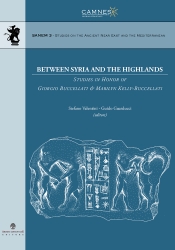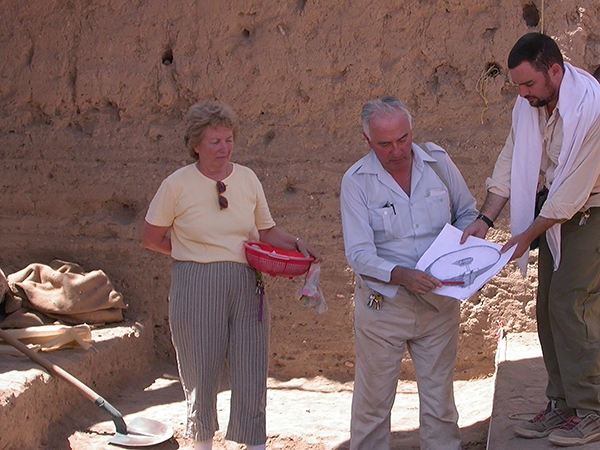Volume of Studies Honors Giorgio Buccellati and Marilyn Kelly-Buccellati

The long, distinguished, and prolific careers of Giorgio Buccellati and Marilyn Kelly-Buccellati are honored in the recent publication of a volume of studies, Between Syria and the Highlands, authored by 51 scholars from universities and research centers around the world. Giorgio Buccellati is professor emeritus of the departments of History and Near Eastern Languages and Cultures and the founding director of the Institute of Archaeology at UCLA (now the Cotsen Institute of Archaeology). He is also the director of the Mesopotamian Laboratory. Marilyn Kelly-Buccellati is professor emerita of archaeology and art history, California State University–Los Angeles. Both are researchers affiliated with the Cotsen Institute. They have worked for many years in the Near East and served as directors of the archaeological expedition to Tell Mozan (ancient Urkesh) in northeastern Syria.
In her contribution to the volume, Willeke Wendrich, director of the Cotsen Institute, wrote: “When I think of Giorgio and Marilyn, I think of…equally impressive scholars, who have always worked closely together, but who remain distinct persons, with their own careers. Co-directing excavations, authoring articles and books together, requires great talent in delivering and accepting input, ideas, and critique…They are the scholarly giants on which next and future generations of archaeologists stand. Most importantly, they treat the people with whom they work as members of an extended family: their American, Italian, and Syrian students; the women of the villages around Mozan; and their close colleagues in the Department of Near Eastern Languages and Cultures, as well as the Cotsen Institute of Archaeology at UCLA, of which Giorgio was the founding father and Marilyn, the ever-present mother.”
In discussing this Festschrift (a collection of writings published in honor of a scholar or scholars), the Buccellatis admitted that they had no idea that the volume of tributes was in the works until late in 2019, when their son Federico, also an archaeologist who was appointed Director of the Mozan/Urkesh Archaeological Project in May, brought out the book during a Christmas visit. This followed a Skype call with Stefano Valentini and Guido Guarducci, two colleagues from their excavation in Syria who were the editors of the volume. “They were excavating near us in Syria, and they pretty much knew which colleagues to approach for contributions,” Giorgio Buccellati explained. “We said, almost immediately, that we wanted it to be open source online,” he continued, which it now is. The Buccellatis are currently in the process of writing individual letters to each of the contributors “because we are carefully reading what they have written and are responding to their arguments,” he added. The book is included in the series Studies on the Ancient Near East and the Mediterranean, published by the Center for Ancient Mediterranean and Near Eastern Studies in Florence, Italy.
 Valentini noted that, “of Marilyn and Giorgio, I have always appreciated their empathy and their intellectual honesty, supported by an innate ability to communicate, share, and involve the scientific community with the ultimate goal of giving life to an archaeology full of humanity: made up of people and of faces, not only of pottery and of dust. Thanks to them, I gained the awareness that the archaeologist, wherever he is working, must also fulfill his task as cultural mediator: between the cultures of the past and those of the present and between our Western culture and that of the countries we host.”
Valentini noted that, “of Marilyn and Giorgio, I have always appreciated their empathy and their intellectual honesty, supported by an innate ability to communicate, share, and involve the scientific community with the ultimate goal of giving life to an archaeology full of humanity: made up of people and of faces, not only of pottery and of dust. Thanks to them, I gained the awareness that the archaeologist, wherever he is working, must also fulfill his task as cultural mediator: between the cultures of the past and those of the present and between our Western culture and that of the countries we host.”
Guarducci added that “I would like to deeply thank Giorgio for accepting, since the very first day back in 2010, becoming a member of the Scientific Committee of the newborn Center for Ancient Mediterranean and Near Eastern Studies, as well as his and Marilyn’s constant support in the ensuing events that we organized. Thank you, Giorgio and thank you, Marilyn, for your remarkable academic and scientific effort and for your precious friendship.”
In their article, “Integrating Conservation, Archaeology, and Community at Tell Mozan (Urkesh),” Neville Agnew and Martha Demas of the Getty Conservation Institute in Los Angeles, described the work of the Buccellatis as “having woven a beautiful tapestry, integrating archaeology, conservation and community from their deep attachment for the place and people. Their work reflects a blend of scholarly erudition and pragmatic commonsense. They see near and far. Practicing archaeologists who have embraced both site and artifact conservation, innovators and experimentalists, networkers across multiple disciplines with the ability to engage help from others with different expertise—these are the attributes of the Buccellatis. We stand in admiration of their inventive ways of harnessing the benefits of archaeology for a larger purpose and in ways they never would have imagined—as a bulwark against the ravages of war.”
Another chapter, “The Terqa Cloves and the Archaeology of Aroma,” was contributed by Monica L. Smith, professor in the departments of Anthropology and the Institute of the Environment and Sustainability, and core faculty member of the Cotsen Institute. She noted that the starting points for her paper were the tiny botanical remains found by the Buccellatis in their excavations in Terqa in 1976 where they reported cloves from a second millennium BCE context. “It is a great pleasure to offer this modest chapter in honor of Marilyn Kelly-Buccellati and Giorgio Buccellati. Throughout my many years at UCLA, they have been gracious and generous colleagues and friends, with whom it has always been a wonderful pleasure to share conversations about archaeological theory interwoven with warm observations about family life and some wonderful meals.”
“The Scepter from Sitagroi and Early Bronze Age Symbols of Power,” is a chapter written by Ernestine Elster, alumna of the Cotsen Institute and former director of publications, who describes how she first met Giorgio Buccellati in the 1960s during an extension course, which culminated in an optional trip visiting sites and museums. The original Friends of Archaeology was formed as a result of this trip, with Buccellati becoming the faculty advisor. Subsequently, after she received her MA and Buccellati had been appointed director of the newly-established Institute of Archaeology, he asked her to be director of the fledgling publications program, a position she held from 1974 until 2003. In fact, she claims that the Buccellatis “served as unofficial godparents” to The Archaeology of Grotta Scaloria: Ritual in Neolithic Southeast Italy (Cotsen Institute Press, 2016) of which she is co-author. “Our friendship is a long one, studded with family meetings and memorable travels,” she relates.
The Studies on the Ancient Near East and the Mediterranean is the scientific monographic series of the Center for Ancient Mediterranean and Near Eastern Studies, created with the support of Arbor Sapientiae of Rome. A digital copy of Between Syria and the Highlands. Studies in Honor of Giorgio Buccellati and Marilyn Kelly-Buccellati (394 pages) is available at www.avasa.it; a hard copy may be purchased for $157.50.
To support the research or teaching of the Cotsen Institute, or for additional information, please contact Michelle Jacobson at mjacobson@ioa.ucla.edu.
Captions to the Figures
Figure 1. Between Syria and the Highlands. Studies in Honor of Giorgio Buccellati and Marilyn Kelly-Buccellati.
Figure 2. Marilyn Kelly-Buccellati, Giorgio Buccellati, and Federico Buccellati discuss the site of Tell Mozan, ancient Urkesh, in northeastern Syria.
Published on November 2, 2020.


